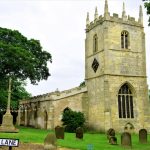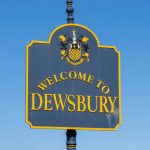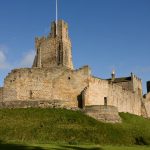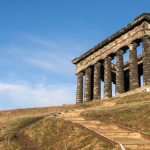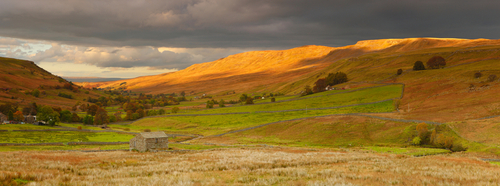
A Quick Guide to Kirkby Stephen
Kirkby Stephen is a small market town and civil parish in the Eden District of Cumbria, northwest England. The town is situated close to the west bank of the River Eden and on the A65 trunk road. It’s positioned approximately 26 miles (41 km) southeast of Penrith and 24 miles (38 km) northeast of Kendal. At the 2011 UK national census, the town had a recorded population of 2,580.
Go to the Cumbria Business Directory
A Fleeting History of Kirkby Stephen
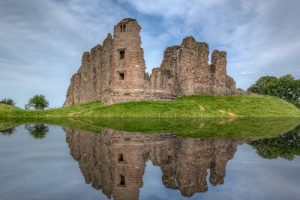
The ruins of Brough Castle are 4 miles north of Kirkby Stephen
Early Times
There is archaeological evidence to suggest that the area around Kirkby Stephen was settled during both the Stone Age and Iron Age. The Romans were also known to be active in the Kirkby Stephen area from the mid-1st century to the early 5th century, as they established a fort (Verterae) 4 miles to the north at the site of Brough Castle. The Anglo-Saxons built a church at the present-day site of St Stephen’s parish church, though almost nothing is known of that time. It may be that Kirkby Stephen itself was not permanently settled until the 10th century when the invading Vikings decided to set up a homestead.
The first written mention of the village of Cherkaby Stephen was recorded in 1090. Kirkby is a corruption of Cherkaby, translating from Old Norse as ”settlement with a church”. However, there are several schools of thought on the origin of ‘Stephen’. Kirkby Stephen was part of the 11th-century Norman manor granted to the Abbey of St. Mary’s at York.
The first Abbot of St Mary’s was Stephen de Whitby, so it is supposed by some that Kirkby ‘Stephen’ was named after him. The second supposition is that the ‘Stephen’ is simply a corruption of ‘on the Eden’. The third theory is that ‘Stephen’ is derived from the Anglo-Saxon word ‘stefan’, which translates as ‘moor’. Thus, Kirkby Stephen’s designation signified a ”village with a church on the moor”. The one thing that experts do seem to agree on is that the name of Kirkby Stephan is not a dedication to St Stephen as it would otherwise be easy to suppose.
In 1170, a parish church was built to replace the old Anglo-Saxon church, which itself was replaced by the present-day St Stephen’s church in about 1230. In 1353, Roger de Clifford, Baron of Westmorland, obtained a charter from King Edward III for a weekly market and two annual fairs to be held in the town. The market assisted Kirkby Stephen’s development as local drovers’ roads and packhorse routes, across the Pennines, soon sprang up.
17th and 18th Centuries
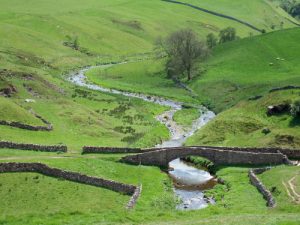
+An old ‘packhorse bridge’ in Smardale
In 1605, a new market charter was granted to George Clifford, Earl of Cumberland, by King James I. It moved the weekly market to a Monday and gave permission for an annual fair to be held at Whitsuntide and another in October. By the 17th century, Kirkby Stephen had also become established as a centre for the production of stockings. In 1671, Sir Daniel Fleming described its market as ”much improved by the trade of stockings, lately taken up”. Writing in 1688, Thomas Denton documented the town’s staple commodity as ”wool and the manufacture of wool”, which was yarn, stockings, caps and cloth. The town’s specialism was maintained across the 18th century but attempts to move its textile production to an industrial scale, ultimately failed.
Nonetheless, by the end of the 18th century, Kirkby Stephen appeared to be thriving. A business directory from 1784 listed the town as having; 10 shopkeepers, 2 butchers, 3 comb makers, 2 tallow chandlers, 2 clockmakers, a saddler, a tobacconist and a bookbinder. Professional people included a parson, 2 attorneys, 2 surgeons, a schoolmaster, a mathematician and several apothecaries, male midwives, skinners and tanners, as well as a dancing master and a wandering musician.
The 19th Century
In the early 19th century, a tannery was established in the town but its tenure proved to be short-lived. However, industries that did grow in importance in 19th century Kirkby Stephen, included brewing, the quarrying of limestone and brockram (aka breccia), and the production of quick-lime. Nevertheless, the population increase in the town proved to be very modest, rising from 1,141 in 1801, to 1,339 in 1851, and in the latter part of the century, remained steady at 1,500 – 1,600.
In August 1861, Kirkby Stephen East railway station was opened by the South Durham & Lancashire Union Railway on their link between Barnard Castle and Tebay. In June 1862, a second rail line and station opened, the Eden Valley Railway and Kirkby Stephen station. It ran from the town, via the upper Eden Valley, to Clifton, about 4 miles south of Penrith. The main purpose of these railways was to carry freight rather than passengers. High-grade iron ore was transported from Cumberland and Lancashire to the blast furnaces of the North East. Coal and coke from the mines of Durham were shipped in the opposite direction. The route was shorter, and thus, shipments could be made cheaper, than via the alternative of the Lancaster and Carlisle Railway, which had opened in 1846.
The Modern Era
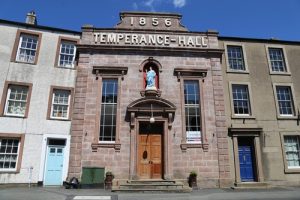
*The Temperance Hall – 1 of 52 Listed Buildings in Kirkby Stephen
Kirkby Stephen saw its rail passenger travel peak in the 1930s. Starting in 1932, express trains from both Newcastle and Darlington stopped at Kirkby Stephen East on the way to and from Blackpool. The Durham Miners’ special, which ran between 1932 – 1936, also stopped at the station, taking hundreds of working-class families from the North East on their annual holiday to the seaside.
In 1962, the closure of the Barnard Castle and Tebay railway line saw the end of Kirkby Stephen East. The station was in time converted to a bobbin factory, which subsequently closed in 1992, after the company went into receivership.
Today, most of Kirkby Stephen lies within a conservation area, which contains the town’s predominately 18th and 19th-century houses, built of the local brockram stone. There are 52 Grade II Listed Buildings and Structures on the English Heritage register within the parish. The local economy is particularly reliant on consumer services due to the importance of the area’s tourist industry. However, public services, distribution and agriculture also make a major contribution to local commerce.
Kirkby Stephen serves as one of the main bases for tourism in the Upper Eden Valley, which especially attracts walkers. The long-distance walking routes which pass through or near Kirkby Stephen, include Alfred Wainwright’s Coast to Coast, Lady Anne’s Way, The Pennine Journey, The Eden Way and Yoredale Way.
How to get to Kirkby Stephen?
By Road
Getting to Kirkby Stephen by road is fairly straightforward. Turn off the M6 at Junction 38 (Tebay) onto the A685 – Kirkby Stephen is 12 miles further on. From the North, the M6, A66, and A685 provide a slightly shorter route. From the East side of the country, take the A66 and A685.
By train
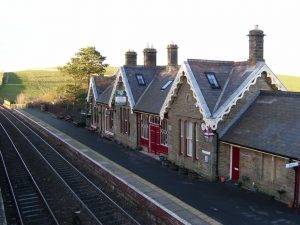
Cyberdemon007 at the English Wikipedia, CC BY-SA 3.0 , via Wikimedia Commons
Kirkby Stephen is a stop on the famed Settle-Carlisle Line, considered by many to be the most scenic rail route in the UK. The line is operated by Northern and forms part of the longer Carlisle – Leeds Line. Kirkby Stephen is around 42 miles (68 km) south of Carlisle and the rail journey takes about 55 minutes. From Leeds, the northwest journey is about 56 miles (90 km) and takes 1 hour 30 mins. There are 8 trains in either direction daily with a reduced service on Sundays.
By coach
National Express buses pass through Kendal (26 miles) and Penrith (24 miles) on a daily basis. Local service buses run to Kirkby Stephen approximately every 2 hours from either town.
By Air
The nearest international airport to Kirkby Stephen is Newcastle which is 82 miles (131 km) away. Carlisle’s small domestic airport is 53 miles (85 km).
Did you know?
- St Stephen’s Parish Church has a number of interesting relics, one of which is the ”Loki Stone”. The Viking stone carving dates from 900 – 1000 AD and depicts the Norse god Loki. In Norse mythology, Loki was bound to a large stone by his fellow gods. He was then tormented by fiery venom, which dripped from the mouth of a serpent. The rare carved stone is one of only two such objects in the whole of Europe.
- Kirkby Stephen’s narrow masonry arch footbridge over the River Eden, ”Frank’s Bridge” is thought to be named after Francis Birbeck, a local brewer. The 17th-century bridge formed part of the ‘corpse lane’ which coffins were carried along from nearby villages for burial at St Stephen’s church.
- Frank’s Bridge is said to be haunted by ‘Jangling Annas’. She is said to have been a prisoner at nearby Hartley Castle, who managed to escape while still in her chains but drowned in the river near the bridge.
Sport
Kirkby Stephen FC
Kirkby Stephen FC currently (2020) play their football in the Westmorland League. They play their home games at Parrot Park.
Kirkby Stephen Hockey Team
Kirkby Stephen runs ladies’, men’s and junior hockey teams that play their home games at Kirkby Stephen Grammar School.
Things to see and do in Kirkby Stephen!
- Stainmore Railway Company – is a volunteer-run heritage railway, housed at the former Kirkby Stephen East station. It’s open at weekends between 10 am – 4 pm from Easter until mid-December. Admission is free but there are charges for train rides and other special events that take place on selected weekends. There are a small museum, shop and cafe housed in a vintage buffet car on site.
- Brough Castle – is strategically located on the desolate Stainmore Pass, at the site of an old Roman fort. Dating from around 1200, the castle was restored in the 17th century by Lady Anne Clifford. The castle is open all year-round apart from closing for only 3 days over Christmas. There are a gift shop and small cafe on-site with an ice cream parlour and tearoom close by.
- Sunsoar Paragliding Ltd – is based in Kirkby Stephen and teaches people to paraglide. You can learn as a complete beginner or any standard up to Club Pilot level. The company also trains students in a good number of locations both in the UK and overseas.
- St Stephen’s Parish Church – is around 800 years old and stands on the site where there was once both an Anglo-Saxon and Norman church. The impressive building is the second largest parish church in Cumbria, which gives rise to it being dubbed by some as ‘the Cathedral of the Dales’. It retains carved stones from the earlier Norman church and a ‘Loki Stone’ from the Viking Era (See above).
- Ewbank Scar – with its panoramic scenic views and cascading waters, was a favourite Victorian beauty spot. It’s also a Site of Special Scientific Interest (SSSI) which is particularly noted for its limestone grasslands and semi-natural woodland.
- Smardale Gill Nature Reserve – stretches for some 6 miles from Newbiggin-on-Lune to Kirkby Stephen. Its ancient woodlands and limestone grasslands provide a unique habitat for some of the UK’s rarest plant and wildlife. There are also a number of designated ‘easy’ walking routes.
- Nine Standards Rigg – is a 10-mile round-trip fell walk from Kirkby Stephen to the top of Hartley Fell, which largely follows the route of the Coast to Coast Path. The ‘Nine Standards’ refers to the nine ‘cairns’ which lie close to the summit. The cairns are thought to be up to 800 years old but have been re-built many times over the years. Their original purpose remains unknown.
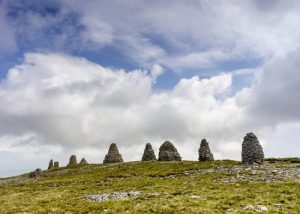
^The nine ‘cairns’ (stone mounds) near the summit of Hartley Fell
Where to stay in Kirkby Stephen?
There are around 7 or 8 places to stay within a 5-mile radius of Kirkby Stephen, which is quality rustic inn/b&b/guesthouse style accommodation. They generally fall into a price range of £80 – £120 per night for 2 adults sharing. There are a number of ‘luxury’ hotels a little further afield but expect to pay £140+ per night.
Thinking of moving?
The average price paid for a property in Kirkby Stephen in the last 12 months (September 2020) was £228,200, which represents a fall of about 4% from the previous 12 months. Semi-detached houses sold for an average of £215,600, terraced houses for £171,900 and flats for £135,100.
Photo credit: *Woozie/+Badihir Yeniceri/^Richard Bowden/shutterstock.com
Why not try our Quiz and see what you remembered?
How much do you know about Kirkby Stephen? Why not take the Five Minutes Spare Town Quiz below, to find out:
Quiz Maker – powered by Riddle
Photo credit: Colin Ward/shutterstock.com
